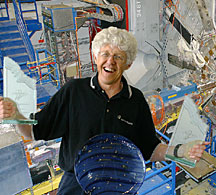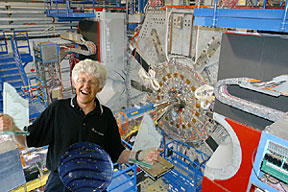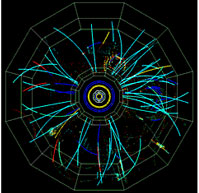| Research
|
|
|||||||||||||||||||||||
|
Cookin' up quark soup at RHIC A standing-room-only crowd attended a special colloquium at DOE's Brookhaven National Laboratory on June 18 to hear the latest results from the Relativistic Heavy Ion Collider (RHIC). The findings strengthen the scientists' confidence that RHIC's collisions of gold ions have created unusual conditions and that they are on the right path to discover a form of matter called the quark-gluon plasma, believed to have existed in the first microseconds after the birth of the universe.
"These results are profoundly important," said Raymond L. Orbach, Director of DOE's Office of Science, in a statement issued prior to the colloquium. "They go to a fundamental question in science: How did the universe look at the beginning of time? People have always been fascinated by the question of how our world began." More than 1,000 scientists—including physicists from Ames, Argonne, Brookhaven, Lawrence Berkeley, Lawrence Livermore, Los Alamos, and Oak Ridge national labs—have collaborated on these experiments. While the scientists are not yet ready to declare the discovery of quark-gluon plasma—a claim that must await corroborating experiments, now under way at RHIC—the excitement in the room was palpable. Special guests included John Marburger, director of the Office of Science & Technology Policy and Science Adviser to the President; Peter Rosen, associate director for High Energy & Nuclear Physics, DOE's Office of Science; and Dennis Kovar, director of DOE's Division of Nuclear Physics within High Energy & Nuclear Physics—who all offered their congratulations to the scientific team. "It's clear that a new fundamental phenomenon has been discovered here," said Rosen. The latest RHIC findings come from experiments in which a beam of heavy gold nuclei collides head-on with a beam of deuterons. These deuteron-gold experiments, along with proton-proton collisions, serve as a basis for comparison with collisions of two gold beams at RHIC. When two gold nuclei collide head-on, the temperatures reached are so extreme that the individual protons and neutrons inside the merged gold nuclei are expected to melt, releasing the quarks and gluons normally confined within them to form a tiny sample of particle "soup" called quark-gluon plasma. In contrast, the small deuteron passes through the large gold nucleus like a bullet, without heating or compressing it very much. In the deuteron-gold and proton-proton experiments, back-to-back jets of ordinary particles were seen to emerge, but in head-on collisions of gold nuclei, one of the two jets was missing. One possible explanation of the missing jets is that one of the two quarks traveling through this new environment would interact strongly and lose a substantial amount of its energy, so its jet would get stuck, or "quenched," in the "soup." If further research proves that RHIC has re-created quark-gluon plasma, the physics story has just begun. By studying the behavior of free quarks and gluons in the plasma, RHIC scientists hope to learn more about the strong nuclear force—the force that holds quarks together in the atomic nuclei all around—and in—us. Submitted by DOE's Brookhaven National Laboratory |





